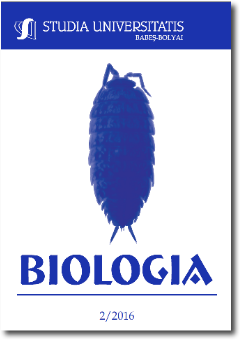Physico-chemical properties of soils populated with wild halophytes in some Romanian areas
Keywords:
conductivity, halophytes, pH, redox potential, salinity.Abstract
Soil salinity is one of the most important abiotic stress factor which reduces crop productivity worldwide, limits plant survival rate and restricts the use of arable land. Romanian saline soil areas are located on the seaside of the Black Sea and in different inland regions of the country. Nine Romanian sampling sites were analyzed, several obligative and facultative halophytes were identified.The main objective of the present study is to determine physical and chemical properties (pH, conductivity, salinity, redox potential) of some soil samples of saline areas from the Transylvanian Basin in order to give a better understanding about further characterization of halophytes adaptation mechanisms.
References
Bacchetta, G., Farris, E., Pontecorvo, C. (2012) A new method to set conservation priorities in biodiversity hotspots, Plant Biosystems 146, 638-648
Bazihizina, N., Timothy, D., Edward, G. (2009) Response to non-uniformsalinity in the root zone of the halophyte Atriplex nummularia: growth, photosynthesis, water relations and tissue ion concentrations, Annals of Botany 104, (4), 737–745.
Blaga, G., Filipov, F., Paullete, L., Rusu, I., Udrescu, S., Vasile, D. (2008) Pedologie. Ed. Mega Cluj Napoca, 450 p
Blumwald, E., Poole, R. J. (1985) Na(+)/H(+) antiport in isolated tonoplast vesicles from storage tissue of Beta vulgaris. Plant Physiol., 78, 163–167
Bromham, L. (2014) Macroevolutionary patterns of salt tolerance in angiosperms. Ann. Bot., 1–9
Cadaret, E. M., Nouwakpo, S. K., McGwire, K. C., Weltz, M. A., Blank, R. R. (2016) Experimental investigation of the effect of vegetation on soil, sediment erosion, and salt transport processes in the Upper Colorado River Basin Mancos Shale formation, Price, Utah, USA, Catena, 147, 650–662
Ciocârlan, V. (2009) Flora ilustrată a României. Pteridophyta et Spermatophyta, Ceres, Bucureşti, pp. 225-226
Cristea, V. (2010) Conservarea ex situ prin culturi in vitro fotoautotrofe a taxonilor endemici şi cu diferite grade de periclitare aparţinând genului Dianthus din România, In: Culturi in vitro fotoautotrofe la specii de Dianthus endemice şi periclitate din România, Cristea, V., Todesco, Cluj-Napoca, pp 145-194
Farissi, M., Ghoulam, C., Bouizgaren, A. (2013) Changes in water deficit saturation and photosynthetic pigments of alfalfa populations under salinity and assessment of proline ole in salt tolerance. Agric. Sci. Res. J., 3, 29–35
Guo, Y. S., Wan-Ke, Z., Dong-Qing, Y., Bao-Xing, D., Jin-Song, Z., Shou-Yi, C. (2002) Overexpression of proline transporter gene isolated from halophyte confers salt tolerance in Arabidopsis. Acta Bota. Sinica, 44, 956–962
Himabindu, Y., Chakradhar, T., Reddy, M. C., Kanygin, A., Redding, K. E., Chandrasekhar, T. (2016) Salt-tolerant genes from halophytes are potential key players of salt tolerance in glycophytes, Environmental and Experimental Botany, 124, 39–63
Krishnamoorthy, R., Kim, K., Subramanian, P., Senthilkumar, M., Anandham, R., Sa, T. (2016) Arbuscular mycorrhizal fungi and associated bacteria isolated from salt-affected soil enhances the tolerance of maize to salinity in coastal reclamation soil, Agriculture, Ecosystems and Environment, 231, 233–239
Kumar, A., Kumar, A., Lata, C., Kumar, S. (2016) Eco-physiological responses of Aeluropus lagopoides (grass halophyte) and Suaeda nudiflora (non-grass halophyte) under individual and interactive sodic and salt stress, South African Journal of Botany, 105, 36–44
Li, X., Wan, S., Kang, Y., Chen, X., Chu, L. (2016) Chinese rose (Rosa chinensis) growth and ion accumulation underirrigation with waters of different salt contents. Agric. Water Manag., 163, 180–189
Muchatea, N. S., Nikalje, G. C., Rajurkar, N. S., Suprasanna, P, Nikamd, T. D. (2016) Physiological responses of the halophyte Sesuvium portulacastrum tosalt stress and their relevance for saline soil bio-reclamation, Flora, 224, 96-105
Munns, R., Tester, M. (2008) Mechanisms of salinity tolerance. Annu. Rev. Plant Biol., 59, 651–681
Shabala, S., Mackay, A. (2011) Ion transport in halophytes. Adv. Bot. Res. 57, 151–199
Yan, K., Xu, H., Zhao, S., Shan, J., Chen, X. (2016) Saline soil desalination by honeysuckle (Lonicera japonica Thunb.) depends on salt resistance mechanism. Ecol. Eng., 88, 226–231
Wang, D., Wang, H., Han, B., Wang, B., Gua, A., Zheng, D., Liu, C., Chang, L., Peng, M.,Wang, X. (2012) Sodium instead of potassium and chloride is an important macronutrient to improve leaf succulence and shoot development forhalophyte Sesuvium portulacastrum. Plant Physiol. Biochem., 51, 53–62
*** (1996) US-EPA 3050B, Acid digestion of Sediments, Sludge and Soils
*** (2000) Directive 2000/60/EC of the European Parliament and of the Council of 23 October 2000 establishing a framework for Community action in the field of water policy, Official Journal of the European Communities, L327/72
*** (2005) ISO10390 Soil quality, Determination of pH
*** (2006) ISO 11464 Soil quality, Pretreatment of samples for physico-chemical analysis
Downloads
Published
How to Cite
Issue
Section
License
Copyright (c) 2016 Studia Universitatis Babeș-Bolyai Biologia

This work is licensed under a Creative Commons Attribution-NonCommercial-NoDerivatives 4.0 International License.





